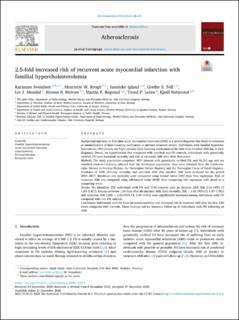| dc.contributor.author | Svendsen, Karianne | |
| dc.contributor.author | Krogh, Henriette Walaas | |
| dc.contributor.author | Igland, Jannicke | |
| dc.contributor.author | Tell, Grethe S. | |
| dc.contributor.author | Mundal, Liv J. | |
| dc.contributor.author | Holven, Kirsten Bjørklund | |
| dc.contributor.author | Bogsrud, Martin P. | |
| dc.contributor.author | Leren, Trond P. | |
| dc.contributor.author | Retterstøl, Kjetil | |
| dc.date.accessioned | 2021-05-31T09:26:12Z | |
| dc.date.available | 2021-05-31T09:26:12Z | |
| dc.date.created | 2021-01-21T13:28:39Z | |
| dc.date.issued | 2021 | |
| dc.identifier.issn | 0021-9150 | |
| dc.identifier.uri | https://hdl.handle.net/11250/2757013 | |
| dc.description.abstract | Background and aims
A first-time acute myocardial infarction (AMI) is a severe diagnosis that leads to initiation or intensification of lipid-lowering medication to prevent recurrent events. Individuals with familial hypercholesterolemia (FH) already use high-intensity lipid-lowering medication at the time of an incident AMI due to their diagnosis. Hence, we hypothesized that compared with matched non-FH controls, individuals with genetically verified FH have increased mortality and risk of recurrent AMI after their first event.
Methods
The study population comprised 4871 persons with genetically verified FH, and 96,251 age and sex matched controls randomly selected from the Norwegian population. Data were obtained from the Cardiovascular Disease in Norway Project, the Norwegian Patient Registry and the Norwegian Cause of Death Registry. Incidence of AMI, all-cause mortality and recurrent AMI after incident AMI were analyzed for the period 2001–2017. Incidence and mortality were compared using hazard ratios (HR) from Cox regression. Risk of recurrent AMI was compared using sub-hazard ratios (SHR) from competing risk regression with death as a competing event.
Results
We identified 232 individuals with FH and 2118 controls with an incident AMI [HR 2.10 (95% CI 1.83–2.41)]. Among survivors ≥29 days after the incident AMI, both mortality [HR = 1.45 (95% CI: 1.07–1.95)] and recurrent AMI [SHR = 2.53 (95% CI: 1.88–3.41)] were significantly increased among individuals with FH compared with non-FH controls.
Conclusions
Individuals with FH have increased mortality and increased risk of recurrent AMI after the first AMI event compared with controls. These findings call for intensive follow-up of individuals with FH following an AMI. | en_US |
| dc.language.iso | eng | en_US |
| dc.publisher | Elsevier | en_US |
| dc.rights | Navngivelse 4.0 Internasjonal | * |
| dc.rights.uri | http://creativecommons.org/licenses/by/4.0/deed.no | * |
| dc.title | 2.5-fold increased risk of recurrent acute myocardial infarction with familial hypercholesterolemia | en_US |
| dc.type | Journal article | en_US |
| dc.type | Peer reviewed | en_US |
| dc.description.version | publishedVersion | en_US |
| dc.rights.holder | Copyright 2020 The Author(s). | en_US |
| cristin.ispublished | true | |
| cristin.fulltext | original | |
| cristin.qualitycode | 1 | |
| dc.identifier.doi | https://doi.org/10.1016/j.atherosclerosis.2020.12.019 | |
| dc.identifier.cristin | 1876575 | |
| dc.source.journal | Atherosclerosis | en_US |
| dc.source.pagenumber | 28-34 | en_US |
| dc.identifier.citation | Atherosclerosis. 2021, 319, 28-34. | en_US |
| dc.source.volume | 319 | en_US |

